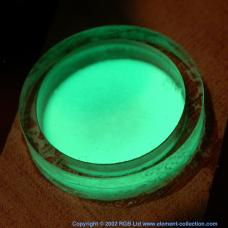Promethium(III) chloride
 Glowing powder mixture of promethium(III) chloride and zinc sulfide
| |
 Crystal structure
| |
| Names | |
|---|---|
| Other names
Promethium chloride; Promethium trichloride
| |
| Identifiers | |
| |
3D model (JSmol)
|
|
| ChemSpider | |
| ECHA InfoCard | 100.034.004 |
| EC Number |
|
PubChem CID
|
|
| |
| |
| Properties | |
| Cl3Pm | |
| Molar mass | 251 g·mol−1 |
| Density | 4.19 g/cm3 (calc., XRD)[1] |
| Melting point | 655 °C (1,211 °F; 928 K)[2] |
| Structure | |
| Trigonal, hP8 | |
| P63/m, No. 176[1] | |
| Related compounds | |
Other anions
|
Promethium(III) oxide |
Other cations
|
Neodymium(III) chloride, Samarium(III) chloride |
Except where otherwise noted, data are given for materials in their standard state (at 25 °C [77 °F], 100 kPa). | |
| Infobox references | |
Promethium(III) chloride is a chemical compound of promethium and chlorine with the formula PmCl3. It is an ionic, water soluble, crystalline salt that glows in the dark with a pale blue or green light due to Promethium's intense radioactivity.
Applications[]
Promethium(III) chloride (with 147Pm) has been used to generate long-lasting glow in signal lights and buttons. This application relied on the unstable nature of promethium, which emitted beta radiation (electrons) with a half-life of several years. The electrons were absorbed by a phosphor, generating visible glow.[3] Unlike many other radioactive nuclides, promethium-147 does not emit alpha particles that would degrade the phosphor.[4]
References[]
- ^ a b Weigel, F.; Scherer, V. (1967). "Die Chemie des Promethiums". Radiochimica Acta. 7. doi:10.1524/ract.1967.7.1.40. S2CID 201840710.
- ^ Haynes, William M., ed. (2011). CRC Handbook of Chemistry and Physics (92nd ed.). Boca Raton, FL: CRC Press. p. 4.84. ISBN 1-4398-5511-0.
- ^ Haynes, William M., ed. (2011). CRC Handbook of Chemistry and Physics (92nd ed.). Boca Raton, FL: CRC Press. p. 4.28. ISBN 1-4398-5511-0.
- ^ Lavrukhina, Avgusta Konstantinovna; Pozdnyakov, Aleksandr Aleksandrovich (1966). Аналитическая химия технеция, прометия, астатина и франция [Analytical Chemistry of Technetium, Promethium, Astatine, and Francium] (in Russian). Nauka. p. 118.
Categories:
- Promethium compounds
- Chlorides
- Lanthanide halides
- Inorganic compound stubs